The last post was all about my love for the classic Mission: Impossible TV series. But what about the recent movie franchise? Well, that’s a whole other beast.
Sure, there are superficial connections, the most obvious ones being the catchy music, the maze-like plots, and the use of face masks. Both incarnations feature a fair amount of visual storytelling and both definitely owe a lot to Alfred Hitchcock and Jules Dassin. They also employ their era’s equivalent of high tech (when the agents played by Emilio Estevez or Simon Pegg hack into elevator systems, it does come across like a logical update of the trick used in the neat episode ‘The Double Circle’). Above all, the two series mostly see in the spy genre a pretext to do heist-based thrillers.
Nevertheless, ultimately the film series operates with a very different spirit from the show. The TV stories relied less on frenetic action than on deliberately paced psychological strategies and intricate sting operations (most of the gunshots took place off-screen, usually at the end, as the IMF agents walked away after having conned their targets into killing each other). Conversely, the films keep moving from one spectacular set piece to the next, laying increasing emphasis on Tom Cruise’s stunts. Moreover, while much of the show’s appeal was to watch a team of super-competent professionals coldly doing their jobs with clockwork precision, the film series revolves around a single protagonist – Ethan Hunt – with a chip on his shoulder. If the former went about rescuing dissidents, toppling dictators, and framing mobsters without ever questioning their missions, the latter tends to save the world from mass destruction and, more often than not, ends up fighting his own organization…
At its best, the new approach reflects a post-Watergate, post-Cold War order without a well-defined enemy, where an US agent is never entirely sure who he is working for and if he can trust his own government (which may have been infiltrated or perhaps was just evil all along). At its worst, the whole thing feels too much like a set of Cruise-centric vanity projects (just look at the posters below!). Initially, the result was so removed from the original concept that the only reason to keep the same title appeared to be cynical branding.
The truth is that, for all its Rube Goldberg-like schemes and games of cat-and-mouse, there was still something ‘adult’ and sophisticated about the TV series, whereas the films trade mostly in juvenile thrills. In that sense, you can find much worthier successors to the 60s’ show in David Mamet’s con movies (especially House of Games and The Spanish Prisoner) or in John McTiernan’s remake of The Thomas Crown Affair. And yet, the M:I flicks are not without their merits…
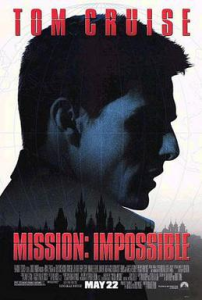
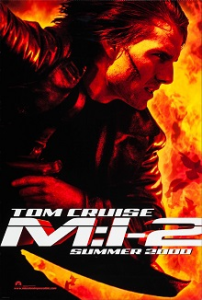
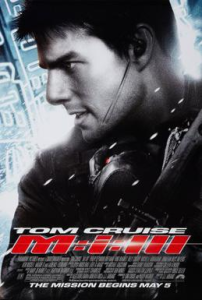
Kicking things off in 1996, the first film, directed by Brian De Palma, already departed from the show’s format by focusing on an agent going rogue and working on his own to clear his name. Still, there were nods to the original: the film opened with what looked like the ending of a typical M:I episode and went on to revisit trademark moments like the bombastic credits, the debriefing tape scene, and the bit with the team laying out their plans. There was also the Rififi-like heist sequence at Langley, which became instantly iconic and set the standard for the sequels. Then again, Jim Phelp’s arc would’ve had much more impact if he had actually been played by Peter Graves…
The second installment went not only with another Hitchcock-influenced director (John Woo), but also with a Hitchcock-influenced plot (it’s been called a loose remake of Notorious, with yet another rogue IMF agent in the Claude Rains role). Regardless, what we ended up with was a cartoonish action movie that was even further away from the original series – instead of smart, committed heroes and villains, the whole thing was full of cardboard characters trying to sound bright but not quite pulling it off. The only way to appreciate it was as a schlocky popcorn blockbuster – leave your brain at the door and just enjoy that kickass final chase scene with Cruise shooting up goons on a high-speed motorbike!
By the time Mission: Impossible III hit the screens, in 2006, you knew what to expect – nothing too brainy, just a stylish shot of adrenaline, and boy did it deliver. After all, unpretentious entertainment bursting with slick, rip-roaring adventure is J.J. Abrams’ specialty! Still, I suppose this was the entry that elevated the constant betrayals and layers upon layers of deception from mere plot mechanics into the series’ thematic identity. You also got sharper dialogue and more of a heart, including some well-handled family drama, as Ethan Hunt was now retired and engaged… For once, the biggest departure from the show wasn’t a descent into basic caricature, but a willingness to invest some of the cast with a bit more depth and humanity (relatively speaking, of course). Plus, it helped that the main villain was played by Phillip Seymour Hoffman in a typical knockout performance (well, two performances).
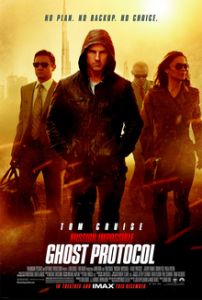
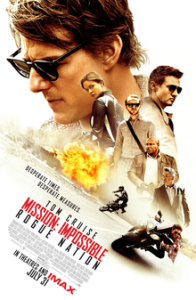
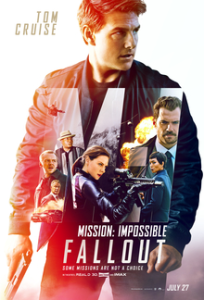
2011’s Mission: Impossible – Ghost Protocol was more of the same, in the best possible sense. It provided the by-now-customary twists and turns of the plot without taking itself too seriously (yep, Hunt was disavowed once again) and it definitely delivered on the spectacular stunts front. Director Brad Bird brought to the proceedings the manic energy and visual awe from his previous work in animation (The Iron Giant, The Incredibles, Ratatouille). The Dubai sequence, with Tom Cruise climbing the Burj Khalifa, was especially breathtaking! As a bonus, the whole bit in which the IMF team intercepts a transaction by simultaneously tricking the two sides in nearby hotel rooms does seem like a scheme straight out of the old M:I show (it also brings to mind Johnnie To’s Drug War, which came out in the following year). Meanwhile, Ethan Hunt grew into this ultra-resourceful powerhouse who is always the most outrageously skilled guy in the room (he is basically Cruise’s version of Batman).
Christopher McQuarrie then took the helm of the series, writing and directing 2015’s Rogue Nation, which picked up shortly after the dénouement of the previous installment and built up on the new status quo, pitting the disbanded members of the IMF against the powerful Syndicate (which is no longer the mob from the TV show, but a whole network of rogue agents). In other words, if Ghost Protocol – with its globetrotting exoticism, inventive gadgets, and consistently comedic tone – was like watching a (less sexist) vintage James Bond flick, then Rogue Nation was M:I’s Quantum of Solace. (This isn’t a bad thing: I’ve come around on Quantum of Solace, which may not be the flashy, lighthearted froth most people expect from a Bond picture, but it’s a damn good action yarn and a treat for those who enjoy a more ruthless depiction of 007 – the kind you also find in the comics of Warren Ellis and Andy Diggle.) McQuarrie confidently hit all the beats with a straight face yet enough self-awareness to toy with how over-the-top the franchise had become… At one point, Alec Baldwin actually described Cruise’s character by saying: ‘Hunt is the living manifestation of destiny!’ Plus, we got yet another Hitchcock riff in the form of a cool set piece at a Vienna opera house, which was an obvious nod to the climax of The Man Who Knew Too Much.
With Fallout, Christopher McQuarrie continues to turn the series into a more streamlined ongoing saga. This is a hardcore, straight-up sequel to Rogue Nation, including callbacks to all of the previous movies. McQuarrie lacks the panache of the earlier directors, but he knows what he’s doing… The first half feels the closest to the old show, with a puzzle-like plot (about McGuffin-esque plutonium cores) steeped in subterfuge, misdirection, and a fair amount of on-the-ground improvisation. Yet you also get the film series’ motifs: extended action scenes in famous locations, political uncertainty (the villains are a diffuse coalition of terrorists, anarchists, and spies), and a bunch of monologues in which characters comment on how awesome Cruise/Hunt is. There are some timely elements as well – on the one hand, Fallout tries to present the Washington-backed IMF as the heroes by making them a more ingenious and humane alternative to the callous, torture-friendly, collateral-damage-prone CIA; on the other hand, the recurrent assortment of disguises, triple agents, and confusing shadow organizations within shadow organizations seems right at home in the post-truth era of fake news and widespread conspiracy theories.
That said, if you’re looking for sheer excitement and tension, I would still recommend tracking down badass episodes of the original TV series, like ‘Memory,’ ‘The Mercenaries,’ ‘The Exchange,’ ‘Terror,’ and ‘Bag Woman.’
